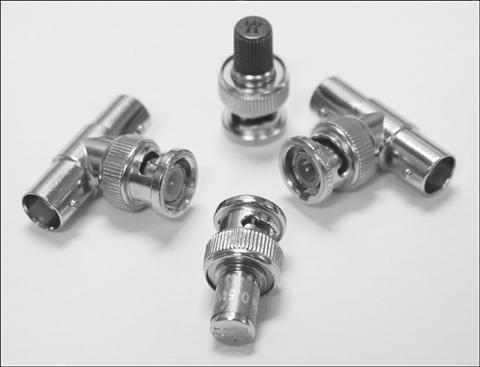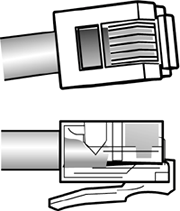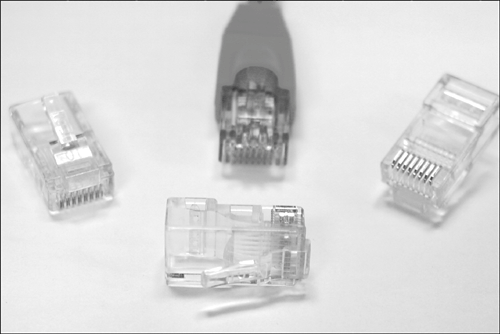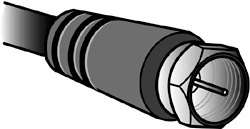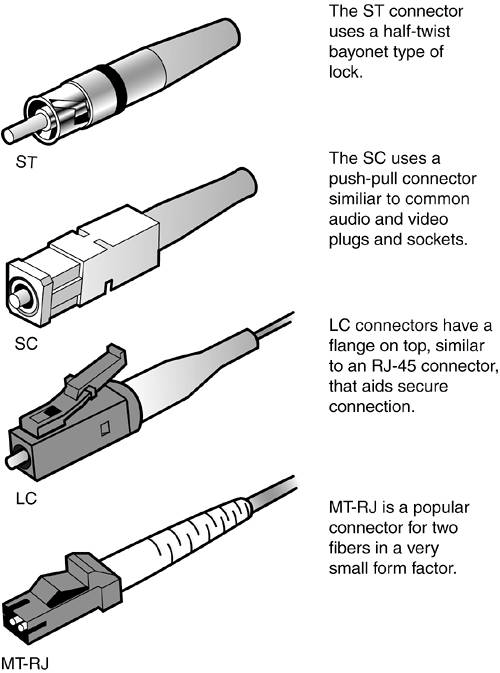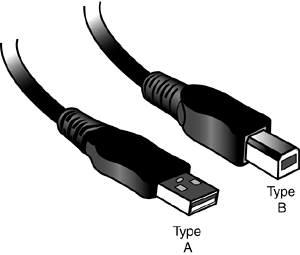Media Connectors
| A variety of connectors are used with the associated network media. Media connectors attach to the transmission media and allow the physical connection into the computing device. For the Network+ exam, it is necessary to identify the connectors associated with the specific media. The following sections identify the connectors and associated media. BNC ConnectorsBNC connectors are associated with coaxial media and 10Base2 networks. BNC connectors are not as common as they once were, but still are used on some networks, older network cards, and older hubs. Common BNC connectors include a barrel connector, T-connector, and terminators. Figure 2.4 shows two terminators (top and bottom) and two T-connectors (left and right). Figure 2.4. BNC connectors.
RJ-11 ConnectorsRJ (Registered Jack) -11 connectors are small plastic connectors used on telephone cables. They have capacity for six small pins. However, in many cases, not all the pins are used. For example, a standard telephone connection only uses two pins, while a cable used for a DSL modem connection uses four. RJ-11 connectors are somewhat similar to RJ-45 connectors, which are discussed next, though they are a little smaller. Both RJ-11 and RJ-45 connectors have small plastic flange on top of the connector to ensure a secure connection. Figure 2.5 shows two views of an RJ-11 connector. Figure 2.5. RJ-11 connectors.
RJ-45 ConnectorsRJ-45 connectors are the ones you are most likely going to encounter in your network travels. RJ-45 connectors are used with twisted-pair cabling, the most prevalent network cable in use today. RJ-45 connectors resemble the aforementioned RJ-11 phone jacks, but support up to eight wires instead of the six supported by RJ-11 connectors. RJ-45 connectors are also larger. Figure 2.6 shows the RJ-45 connectors. Figure 2.6. RJ-45 connectors.
F-TypeF-Type connectors are screw on connections used for attaching coaxial cable to devices. In the world of modern networking, F-Type connectors are most commonly associated with connecting Internet modems to cable or satellite Internet provider's equipment. However, they are also used for connecting to some proprietary peripherals. F-Type connectors have a 'nut' on the connection that provides something to grip as the connection is tightened by hand. If necessary, this nut can be also be lightly gripped with pliers to aid disconnection. Figure 2.7 shows an example of an F-Type connector. Figure 2.7. F-Type connector.
Fiber ConnectorsA variety of connectors are associated with fiber cabling, and there are several ways of connecting these connectors. These include bayonet, snap-lock, and push-pull connectors. Figure 2.8 shows the fiber connectors identified in the CompTIA Network+ objectives. Figure 2.8. Fiber connectors. (Reproduced with permission from Computer Desktop Encyclopedia. © 1981-2005 The Computer Language Company Inc. All rights reserved.)
IEEE1394The IEEE1394 interface, also known as FireWire, is more commonly associated with the attachment of peripheral devices, such as digital cameras or printers, than network connections. However, it is possible to create small networks with IEEE1394 cables. The IEEE1394 interface comes in a 4- or 6-pin version, both of which are shown in Figure 2.9 Figure 2.9. 4-pin (left) and 6-pin (right) IEEE1394 (FireWire) connectors.
Universal Serial Bus (USB)Universal Serial Bus (USB) ports are now an extremely common sight on both desktop and laptop computer systems. Like IEEE1394, USB is associated more with connecting consumer peripherals such as MP3 players and digital cameras than networking. However, many manufacturers now make wireless network cards that plug directly in to a USB port. Most desktop and laptop computers have between two and four USB ports, but USB hubs are available that provide additional ports if required. There are a number of connectors associated with USB ports, but the two most popular are Type A and Type B. Type A connectors are the more common of the two and are the type used on PCs. Although many peripheral devices also use a Type A connector, an increasing number now use a Type B. Figure 2.10 shows a Type A connector (left) and a Type B connector (right). Figure 2.10. Type A (left) and Type B (right) USB connectors.
|
